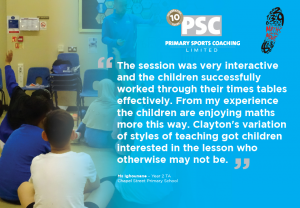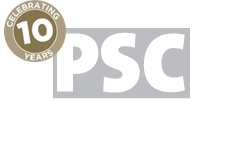8 reasons why children benefit from Physically Active Learning
Indoor break is no fun for teachers. This is partly because it’s harder to set up the classroom for the next lesson or get some marking done, but mainly because teachers instinctively understand that children need the time to move around and prepare their brains for learning.
A growing body of research by cognitive neurologists backs this up, showing that there is increased brain activity and improved on-task behaviours when tackling cognitive tasks following a period of being physically active.
Even with these known benefits, it can be difficult to provide children with regular opportunities to be physically active within the school day, and even harder to ensure they achieve the recommended 30 minutes of in-school moderate-to-vigorous activity every day. One solution is physically active learning (PAL) – an innovative teaching and learning approach which integrates movement into the learning experience.
Maths on the Move (MOTM) is an example of PAL, and covers the KS1 and KS2 National Curriculum for Maths in a physically active manner. In 2019/2020, Leeds Beckett University (LBU) carried out an independent evaluation of the programme, with the following themes emerging through their research.
1) PAL boosts physical activity and reduces sedentary time
Unfortunately, reports suggest that physical activity levels in children are at an all-time low. In order to combat sedentary behaviour, PAL sessions integrate curriculum-based content with physical activities.
The LBU evaluation showed that a single 45-minute MOTM session allowed children to accumulate 6.4 minutes of moderate to vigorous physical activity and 19.8 minutes of light physical activity, whilst reducing sedentary activity by 9.5 minutes. This meant that 28% more children met the recommended amount of activity on a day which includes a PAL session.
2) Facilitates learning and understanding
The LBU evaluation of MOTM was unique in that it examined whether children made progress in a defined area of the KS2 Maths National Curriculum.
By undertaking the MOTM Year 5 Fractions and Decimals programme for 6 weeks, children who attended improved their test scores from 11.3 out of 25 to 18 out of 25. In contrast, the children who continued with their normal classroom-based lessons improved from 10.1 out of 25 to 11 out of 25 – a marked difference.
3) Increases concentration and time on task in other lessons
Many teachers already use brain breaks or energisers to reinvigorate the children in their class and even a short amount of physical activity has been seen to have a positive impact on concentration and attention.
Teachers felt that MOTM sessions provided a similar reprieve to an active break: “They come back in really calm, and it’s nice to see actually they’ve had that energy, but they’ve concentrated.” This indicates that embedding physically active learning sessions in the curriculum can benefit other timetabled lessons in the day.
4) Increases confidence and reduces anxiety
For children who fear maths or have low self-esteem in their ability to think mathematically, changing the learning environment can have a profound effect. By placing the emphasis on learning through games in PAL sessions, children feel more at ease getting involved, allowing them to grow in confidence.
Back in the classroom, children were able to make links between the understanding gained in the PAL lesson and classroom-based learning. Children expressed that they now had more confidence in answering questions, feeling that they knew the answers.
5) Improves resilience
Building resilience in children is of vital importance and there are many advocates for the role of physical activity in supporting children in becoming resilient.
Teachers observed noticeable changes back in the classroom for pupils who had attended MOTM sessions: “In terms of their attitudes towards learning, they seem more resilient and a lot more confident, and they don’t have any tears if they can’t answer any of the questions. They just persevere with it.”
6) A more inclusive approach
Combining maths and physical activity allows children to become more immersed in both the physical activities and the maths challenges. Teachers felt that children who usually engaged with physical activity but not maths, were more involved and vice versa: “Those that don’t like Maths, they’re hooked by the moving, and those that like Maths anyway, they’re just happy to do Maths as well as something else.”
Some pupils who usually believed they were “not that good at sport” felt that they were included more than usual. With that in mind, PAL can prevent isolation by “allowing everyone to get involved and take part in the sessions”.
7) Allows for collaboration and team work
PE lessons often provide opportunities for children to work together but maths lessons tend to involve less teamwork. By grouping children in PAL sessions, you can offer the chance for children to discuss and share their maths understanding, allowing them to give and receive feedback and understand different perspectives.
It also provides healthy competition between teams which draws out the importance of working as a team: “We had to work as a team because you had to interact with other people to know what they got.”
8) Fun, exciting and enjoyable
Any intervention that is not well received by the children will struggle to maintain its position in a busy timetable and is unlikely to have a positive impact.
Children who took part in the MOTM programme really wanted to continue with the sessions after the programme had concluded, saying: “I think it would be really good if it continues because it’s really fun and always gets me awake for the day” and “If it continues, it will help us learn more Maths, it would help us generate even better grades”.
In summary, the data to support physically active learning is compelling, and the accompanying feedback from both children and teachers provides a deep and insightful exploration into how this can work in schools practically.
If you would like to know more about the research conducted on MOTM or would like to see how it could work for your school, you can find more details at https://www.primaryscl.co.uk/maths-on-the-move/ or contact us at daveu@primaryscl.co.uk and our team of experts can discuss your options.

